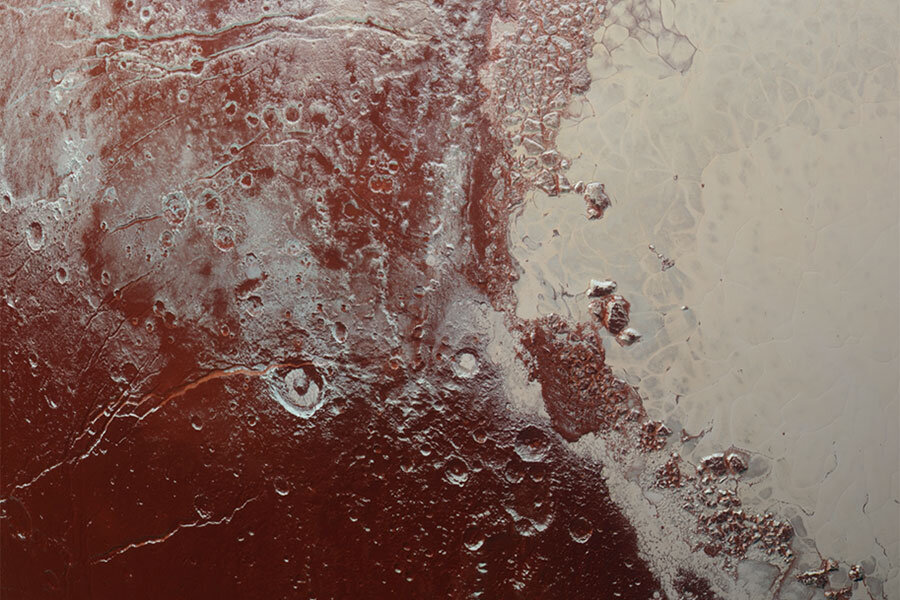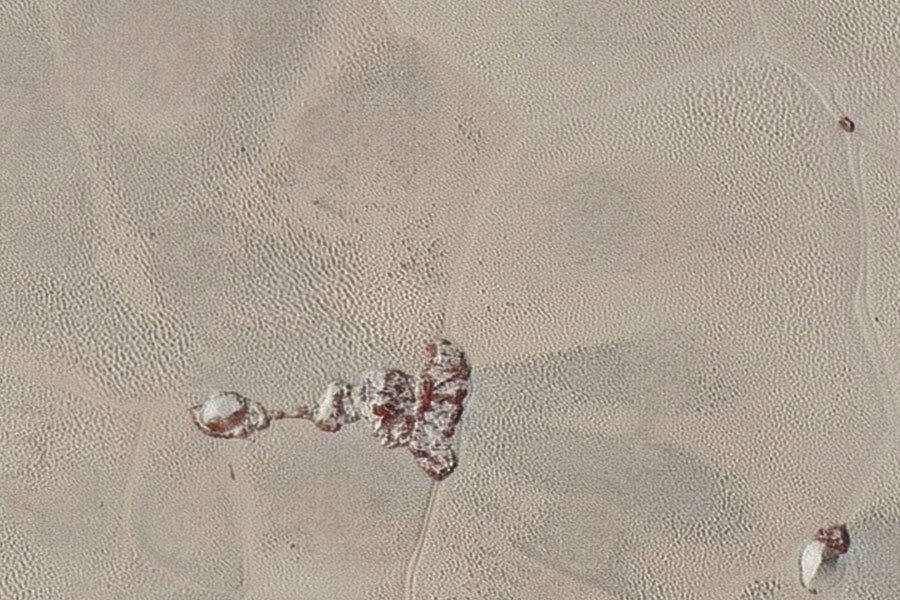Stunning new Pluto images: Could we have imagined this 50 years ago?
Loading...
First it was towering mountains of ice and a surprisingly crater-free plain. Now it’s icy terrain with a snakeskin vibe and a section of the plain covered in tiny dimples, giving it a texture resembling a cantaloupe.
With the release Thursday of several new images from New Horizons’ flyby of the Pluto-Charon system in July, Pluto continues to amaze.
For William McKinnon, a planetary geologist on the New Horizons team who has been studying the formation and evolution of icy moons in the outer solar system for more than 30 years, the landscape the new images reveal is “unique and perplexing.”
It’s a comment that could cover the past half century of planetary discovery, researchers say.
As the first mission to the last of the nine “classic” planets, New Horizons is the flyby bookend to the 53 years of planetary exploration that began with 1962’s Mariner 2 flyby of Venus. The latest photos are a stunning reminder of how radically those years have changed humanity’s understanding of its cosmic neighborhood.
They have revealed a dazzling array of complexity – from massive volcanoes and hydrocarbon seas as large as the Great Lakes – on planets and moons whose processes in surprising ways seem remarkably Earth-like.
They have revealed bodies still very much alive geologically and in the unlikeliest places, driven by tides that heat the innards of distant icy moons and create towering geysers and hidden seas of liquid water.
And as the understanding has grown of how hardy and resilient life is on Earth, recent years have also expanded the number of places beyond Earth where at least simple forms of life may have established beachheads.
“The bottom line is that we’re in the middle of an unbelievable revolution in our understanding of what our solar system is all about,” says Jim Green, who heads NASA’s Planetary Science Division.
Worlds beyond imagination
By mid-2015, more than 180 robotic missions to the moon and beyond had been launched by the United States, Russia, Europe, Japan, China, or India. At the same time, increasingly powerful telescopes have brought once-enigmatic objects into sharper view.
When planetary geologist Geoffrey Collins needs an informal gauge of how much progress has been made, he thumbs through a children’s book about planets published in the 1960s.
“I keep it on my shelf in my office at home ... just to remind me of what people knew” back then, says Dr. Collins, a professor at Wheaton College in Norton, Mass. One entry suggests that Mars could host lichen-like plants.
One thing it could not have guessed at was the sheer complexity of solar-system objects, from the tiny cores of comets to the largest planets, says Carolyn Porco, who heads the imaging team for the Cassini-Huygens mission currently touring the Saturn system.
Asteroids have moons. Ice-covered moons have under-ice oceans. At least one moon, Saturn’s Enceladus, undergoes regular eruptions that spew some of that water into space, making the moon one of the best targets for follow-up missions to hunt for signs of habitability and life. Another Saturn moon, Titan, has lakes and rivers of liquid ethane, methane, and propane replenished by methane rainstorms. The rubber-ducky-shaped nucleus of comet 67P/Churyumov-Gerasimenko – the size of Lower Manhattan – has 19 distinct geological regions.
The new views of Pluto are just the latest example.
On one hand, Pluto was nothing spectacular, just a ball of methane ice in the outer solar system. Later it would be grouped among tens of thousands of objects 62 miles across or larger in a band of primitive objects known as the Kuiper Belt. The belt spans some two billion miles beyond Neptune’s orbit.
“Pluto basically is just another member of the Kuiper Belt; there’s lots of others like Pluto out there,” says Dr. Porco.
Yet “look at the complexity that we’ve found,” she says. Mountains built of ice rather than rock tower 11,000 feet above the surrounding surface. The lack of craters on a vast, smooth plain on one hemisphere suggests a geologically active body. Glaciers of nitrogen ice appear to flow into nooks and crannies of adjacent, rougher terrain. Pluto’s moon Charon – so big compared with Pluto that it is actually considered part of a binary system with each orbiting the other – hosts canyons up to six miles deep. Scaled to an object Earth’s size, that would represent a canyon 63 miles deep.
All of this “tells us that complex processes can occur very, very far from a central star, all throughout the system, and regardless of size,” she says.
The unexpected complexities of our own solar system – something she attributes to a failure of imagination – should give researchers pause as they try to divine conditions in faraway planetary systems.
Indeed, solar-system exploration represents a continuing education in humility for astronomers building their catalog of planets orbiting other stars, suggests Scott Kenyon of the Harvard-Smithsonian Center for Astrophysics in Cambridge, Mass.
“I’m always sobered by these kinds of discoveries,” he says. “We make very complicated models for exoplanets that we can’t see. And we make statements that are very confident. But we’re continually surprised because the universe is varied on scales we sometimes fail to understand.”
Not cheese, but still familiar
But the unexpected also can look reassuringly familiar.
Prior to NASA’s Apollo program to the moon, “there was wild speculation about what the moon was made of,” notes Collins of Wheaton College. But lunar samples gathered by Apollo astronauts, along with spectroscopic studies of other planets, showed that “a lot of the stuff Earth is made of is not that different than what other planets are made of.”
Such similarities have helped researchers interpret what they see in images and other data from space probes.
Other moons far beyond our own have taught similar lessons. Indeed, one key element in the solar system revolution, researchers say, has been the discovery of objects far beyond the rocky inner planets that show evidence for recent, if not current, geological activity – often echoing processes on Earth.
The first evidence came in 1979, when Voyager 1 sped past Jupiter’s moon Io and beamed back images of the moon’s surface.
Once thought to be cold and geologically dead, Io proved to be anything but. Voyager 1’s images revealed a surface remarkably free of impact craters. Instead, it was dotted with large volcanic calderas and covered in extensive lava flows. The craft detected large plumes, pointing to current eruptions. When Voyager 2 arrived four months later, it found that surface features had changed in the interim.
Io’s hot-headedness is unusual for the neighborhood. Its composition is more like the rocky inner planets, where volcanism has been common. Its siblings in the outer solar system are icy. But they, too, are active.
Missions have revealed current or recent activity on several icy moons, including the Jovian moons of Europa and Ganymede, Saturn’s moons Enceladus and Titan, and Neptune’s moon Triton.
Geologically active objects in the outer solar system have cropped up often enough that perhaps it shouldn’t be so surprising anymore, suggests Collins.
“With our views colored by our early experience with the moon, we’re used to things being old and dead. It still comes as a shock when we see things that are active recently or are active today,” he says. “How many times do we have to be surprised in order to stop being surprised?”
Indeed, Pluto’s evidence for geological activity has raised questions about the potential for similar activity – current or geologically recent – on comparably sized, but more-distant Kuiper Belt objects.
Such activity in unexpected places has led to a greater appreciation of tidal heating – the energy source driving it.
In Earth’s case, about half of its internal heat comes from radioactive decay of elements in Earth’s molten mantle; most of the rest is heat left over from the planet’s formation.
But for several of the active bodies in the outer solar system, the heat comes from tidal heating – a gravitational tug-of-war among a host planet and nearby moons.
This tidal heating is “a pretty minor process on Earth, so I don’t think we really appreciated it until we started exploring the outer solar system,” Collins says.
Tidal heating is thought to be responsible for liquid oceans under the icy crusts of Ganymede, Enceladus, and Europa. For Triton, a combination of radioactive decay within its rocky core, plus some residual tidal heating, sustains what’s thought to be an ammonia-rich ocean.
Life, on the rocks
These oceans are of keen interest because they could be potential habitats for organic life. For instance, researchers recently announced that Enceladus’ under-ice ocean is truly global, rather than a sea restricted to the moon’s south polar region. That raises the possibility that the ocean could exhibit a range of ecosystems, not just one peculiar to a specific region, some researchers say.
This has pointed to a deeper insight about habitable environments, particularly in light of the range of bizarre habitats researchers have uncovered on Earth.
“Maybe you don’t need Earth-centered processes to drive life,” Collins says. “Maybe tides can create habitable environments in places that are otherwise completely dark and cold.”
In fact, the past 50 years have significantly impacted scientists’ views on how life might have originated in the solar system. Missions to comets hurtling around the sun from their distant homes in and beyond the Kuiper Belt have revealed primordial material rich in a range of biologically important elements and complex molecules, including amino acids, notes NASA’s Dr. Green.
Those materials were delivered to Earth when outer planets shifted their locations early in the solar system’s history. Researchers now hold that Jupiter, Saturn, Neptune, and Uranus formed in a compact region, then spread outward into their current orbits – perhaps with Uranus and Neptune even switching places.
The migration of the Big Four set off a chain of events that would create Earth’s moon and seed the inner planets with water and prebiotic chemicals. It also would send objects outward to create the Kuiper Belt and the more-distant Oort Cloud and help build the asteroid belt between Mars and Jupiter.
Some of those objects and their remnants continue to pummeled Earth. At least one collision had disastrous consequences for dinosaurs as well as other cratures they shared the planet with at the time.
The role catastrophism has played in shaping the solar system and the trajectory of life on Earth has added yet another reason to pursue solar-system exploration, Green notes.
“It’s of fundamental importance for the survival of life on this planet that we know what our neighborhood is,” he says.









